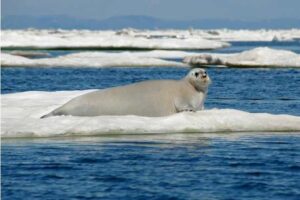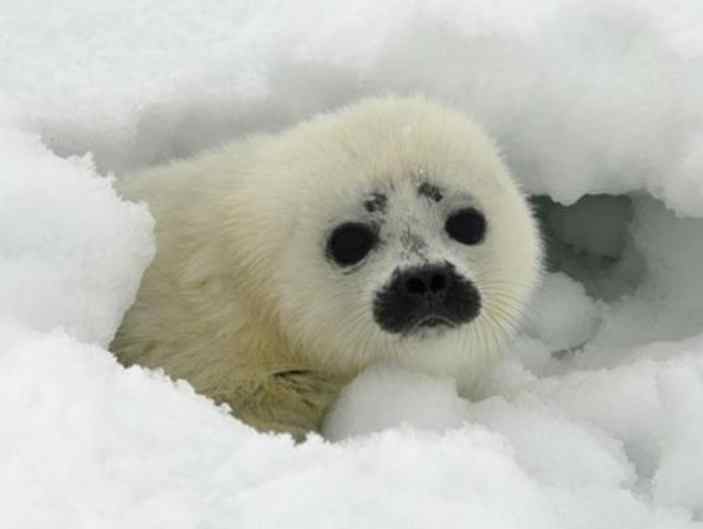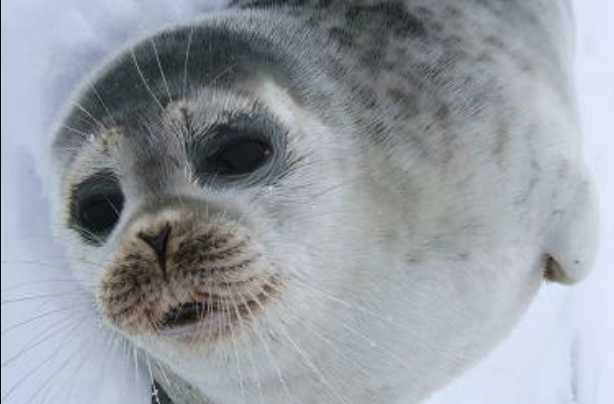
Scientists are using samples from subsistence-harvested bearded seals to establish kin relationships (parent-offspring, siblings) and to produce population estimates. In its first application in Alaska, researchers are using close-kin mark-recapture methods to estimate the size of the bearded seal population.
Close-kin mark recapture methods were developed by Commonwealth Scientific and Industrial Research Organisation (CSIRO) Marine Lab collaborator Mark Bravington. It uses the frequency of kin relationships found in genetic samples, together with a population model, to estimate the size of the population required to produce the observed kin frequencies. We use abundance estimates to manage the species and track changes in the population over time.
In 2012, bearded seals were listed as threatened under the U.S. Endangered Species Act, requiring more accurate data for management. Research biometricians and statisticians, geneticists, and wildlife biologists are collaborating to provide these needed data. Partners in this effort include:
- Alaska Department of Fish and Game
- NOAA’s Alaska Fisheries Science Center
- CSIRO Marine Lab in Australia
- NOAA’s Southwest Fisheries Science Center
“Through this study, we hope to provide more accurate and cost-effective population estimates for bearded seals needed for management under the Marine Mammal Protection Act,” said Brian Taras, biometrician at the Alaska Department of Fish and Game and lead author of the paper.
NOAA Fisheries Marine Mammal Statistician Paul Conn incorporated data collected through a seal biomonitoring program conducted by the Alaska Department of Fish and Game into a model to produce the new estimates of abundance for bearded seals.
Estimates Needed for Subsistence
Resource managers need reliable population estimates for managing species such as the bearded seal, which are a vital subsistence resource for Alaska Native communities.
Bearded seals are dependent on sea ice for pupping, nursing, and molting. The bearded seal was listed as “threatened” under the Endangered Species Act due to predictions about climate change and decreasing sea ice.
Once listed as “threatened,” a species is automatically designated as “depleted” and “strategic” under the Marine Mammal Protection Act and requires annual stock assessment review.
An Independent Check on Aerial Survey Estimates

Previous estimates of bearded seal abundance have primarily been based on aerial surveys. Although such surveys provide valuable information on bearded seal distribution and abundance, they are expensive and require substantial field work.
Seals below the ice or in the water are not visible during aerial surveys, which requires correction factors and introduces uncertainty in population estimates. Annual changes in distribution also make it difficult to determine how population estimates obtained in different locations and years should be combined. Close-kin mark-recapture methods bypass these issues and are an important check on estimates derived from aerial surveys, and represent a new, lower cost monitoring technique.
Scientists used tissue and teeth or claw samples from 1,758 subsistence-harvested bearded seals collected from 1998 to 2020. The data was collected during a long-term biological monitoring program conducted by the Alaska Department of Fish and Game. Researchers analyzed DNA in tissue for genetic makeup and sex, and teeth and claws for age. These samples were collected from 13 Alaskan villages within the range of bearded seals in the Bering, Chukchi, and Beaufort seas.
Using samples from harvested seals avoids the labor and costly research efforts of capturing, marking, releasing, and recapturing marked live seals, which often results in low sample sizes. Another advantage of using harvested animals is that samples are available from long-term harvest monitoring programs. Close-kin mark-recapture modeling with samples from a long-term harvest monitoring program provides relatively large sample sizes, which can be added to over time to improve precision.
Research Findings
Close-kin mark-recapture methods use the genetic makeup of a harvested seal to identify kinship relations among individuals. It looks at relationships such as half-sibling pairs (siblings with one common parent) and parent-offspring pairs. Following rigorous quality control, researchers established kin relationships for 1,484 bearded seals, and included:
- 19 to 25 half-sibling pairs, four of which may have been grandparent-grandchild pairs
- 2 parent-offspring pairs
- No full sibling pairs, which suggests a lack of female-to-male mating fidelity across years
Mitochondrial DNA (DNA inherited only from the mother) identified 68 percent of the half-sibling pairs as paternally related. This provides evidence that only 34 percent of adult males successfully breed. This is consistent with the percent of adult males observed through field studies that maintain stationary breeding territories off the coast of Point Barrow, Alaska.
Close-kin mark-recapture models use the frequencies of observed kin pairs to inform the estimation of adult abundance, adult survival, and the reproductive output of populations over time. This model, in combination with the genetic analysis, produced a population estimate of 409,000 bearded seals. This is close to the estimate produced by aerial surveys with the correction factors applied.
Conclusions and Next Steps
This study has shown that a reliable abundance estimate for bearded seals is possible using close-kin mark recapture methods. By continuing to sample the subsistence harvest, scientists expect to add to the sample size in the future. Abundance estimates will only get more accurate and precise with more data. With more samples, over time this method has the potential to estimate trends in abundance.
“Increased sample sizes will also enable us to refine the model by including aging error,” said Paul Conn, research statistician at Alaska Fisheries Science Center’s Marine Mammal Laboratory. Including aging error (instead of assuming that each seal’s age is known perfectly) in the model will more accurately reflect uncertainty about resulting estimates.
Unexpectedly, this study improved two poorly understood aspects of bearded seal mating strategy. First, on average, only one-third of the adult males (possibly those maintaining territories) are persistently successful breeders. And second, even though females could return to mate with the same territorial males, it appears they do not. These are not findings that scientists could have made using other methods.
Close-kin mark-recapture methods can potentially be applied to other subsistence harvested marine mammals such as:
- Other seal species
- Walruses
- Beluga whales
- Polar bears
Collecting information on these Arctic marine mammals in remote and ice-covered waters is challenging and expensive. Close-kin mark-recapture has potential for producing reliable population estimates and other important information at lower cost.








